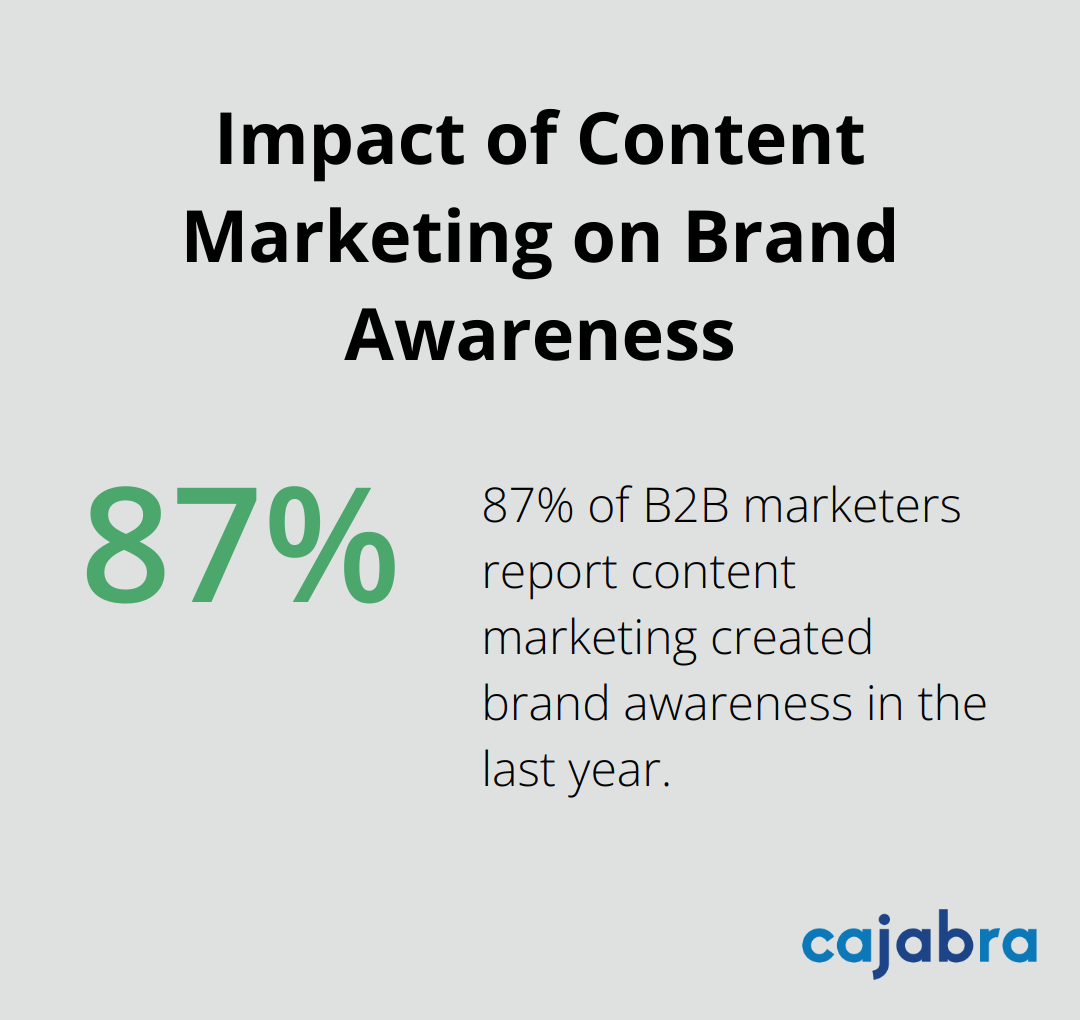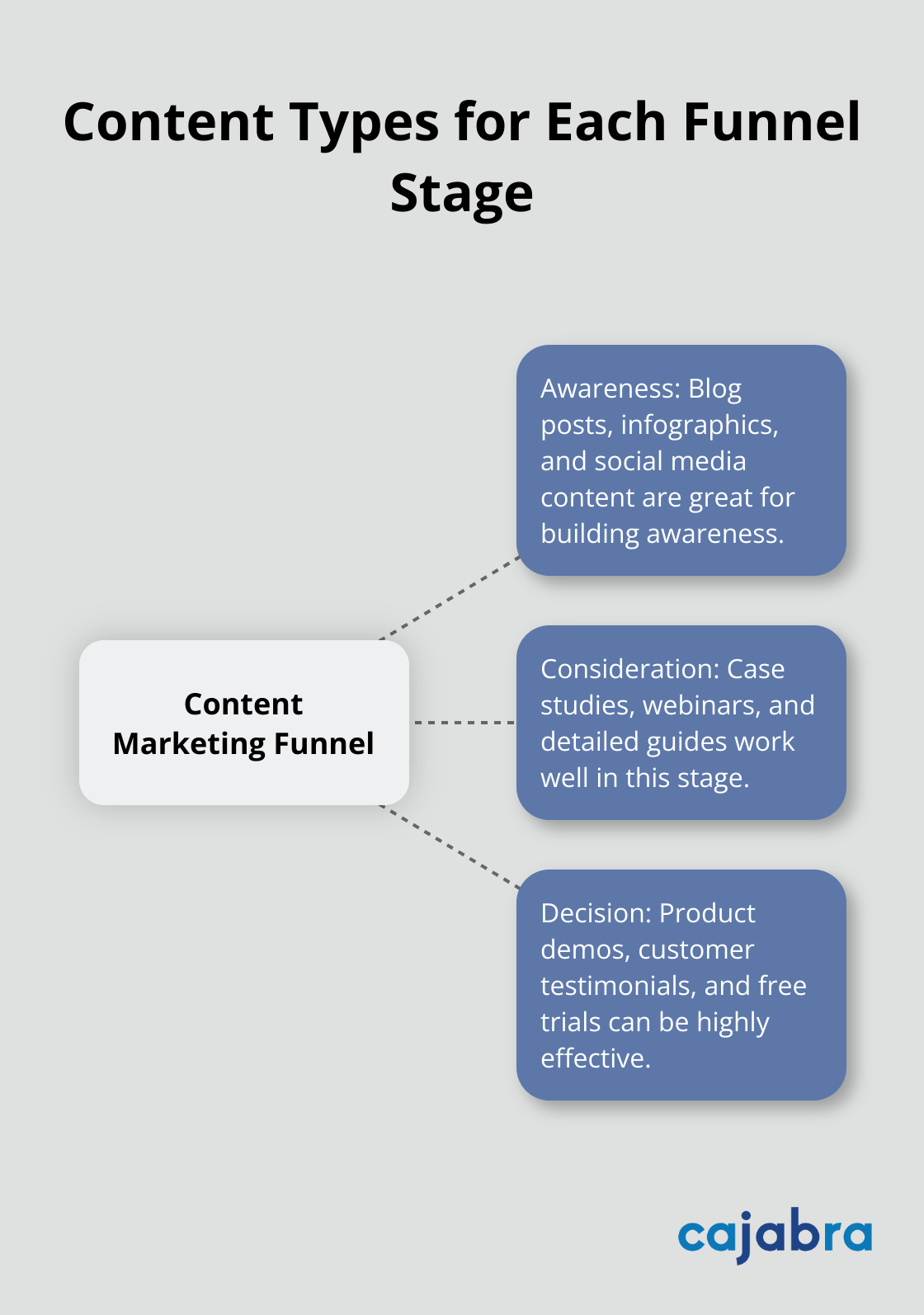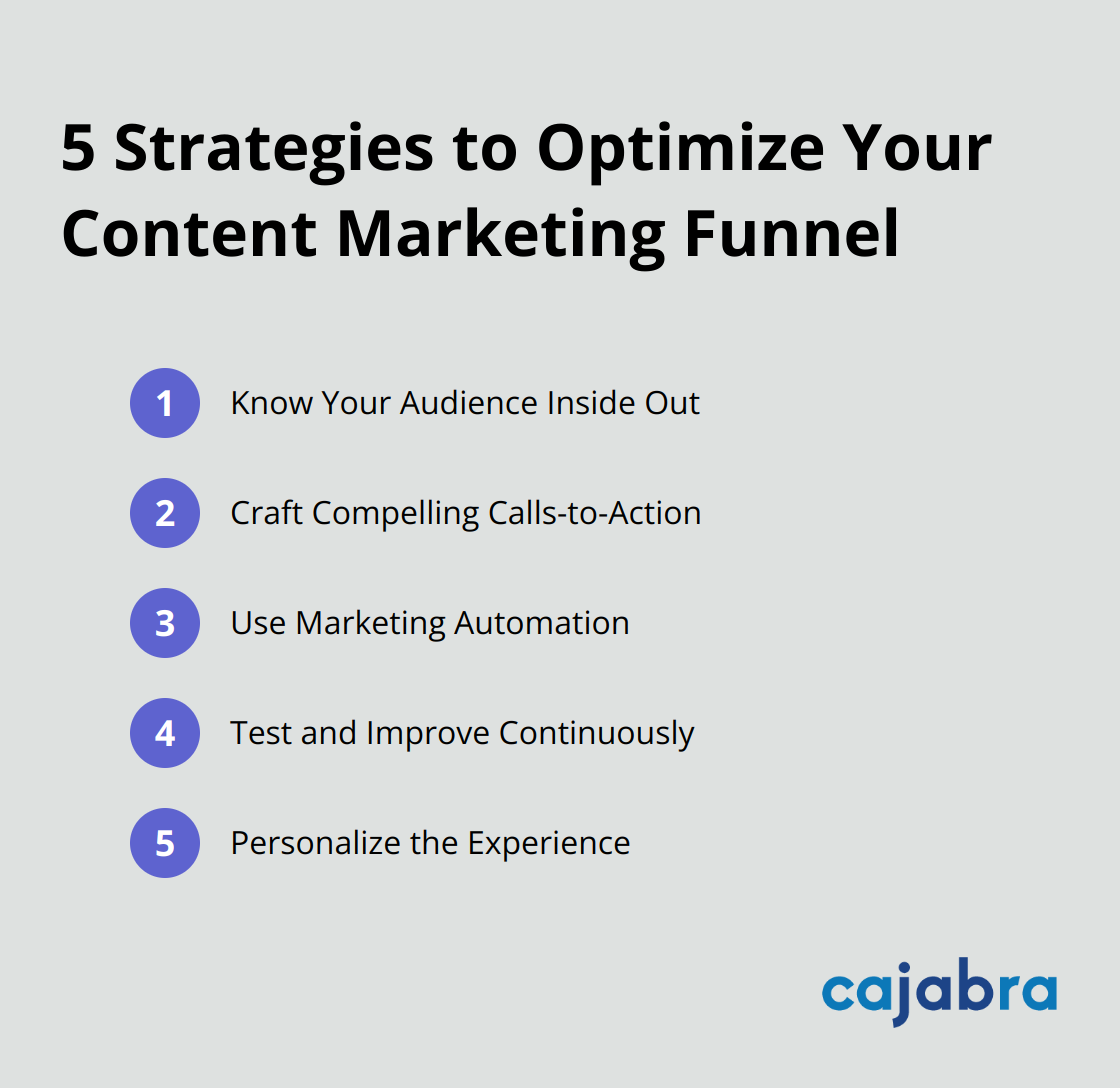
Content marketing funnels are the backbone of successful digital strategies. At Cajabra, LLC, we've seen firsthand how a well-crafted funnel can transform leads into loyal customers.
In this post, we'll break down the key components of an effective content marketing funnel and show you how to create one that drives results. Get ready to supercharge your content strategy and boost your conversion rates.
A content marketing funnel is a strategic approach to guide potential customers through their buying journey using targeted content. This method can significantly boost conversion rates and customer loyalty.
The funnel consists of three main stages: Awareness, Consideration, and Decision. In the Awareness stage, we attract potential customers who may not know about our solutions. During Consideration, we provide more detailed information to help leads evaluate their options. Finally, in the Decision stage, we convert leads into customers.
To measure the effectiveness of your funnel, you need to track specific metrics at each stage:
Different types of content work best at each stage of the funnel:
According to the Content Marketing Institute, 87% of B2B marketers say content marketing created brand awareness in the last 12 months. This underscores the importance of a well-structured content marketing funnel.

A content marketing funnel isn't static. It requires constant refinement based on data and customer feedback. Consistent analysis and optimization of your funnel will improve your marketing efficiency and drive better results for your business.
Now that we understand what a content marketing funnel is and its importance, let's explore how to create effective content for each stage of the funnel.
The top of the funnel requires content that casts a wide net to attract potential customers. Strategies for effective top-of-funnel campaigns include creating valuable content through content marketing, leveraging social media marketing, and addressing common industry pain points.
Infographics visualize complex data effectively. For example, an infographic showing the "Top 10 Financial Regulations Impacting Businesses in 2025" can gain significant traction on social media platforms.
Social media platforms like LinkedIn and Twitter serve as channels to share bite-sized insights and industry news. This approach keeps the audience engaged and positions a brand as a thought leader in the accounting space.
As potential clients progress down the funnel, they seek more detailed information. Webinars prove highly effective at this stage. A webinar on "Maximizing Profitability: Advanced Strategies for Modern Accounting Firms" can attract hundreds of participants and generate numerous leads.
Case studies showcase how real accounting firms benefit from specific services. For instance, a case study titled "How Smith & Associates Increased Revenue by 35%" provides concrete evidence of effectiveness.
Email newsletters maintain engagement over time. A weekly digest of industry news, tips, and exclusive content keeps a brand top-of-mind and nurtures relationships with potential clients.
The bottom of the funnel focuses on converting interested leads into clients. Product demos play a key role here. Personalized demonstrations of tools show exactly how they benefit each specific firm. Industry professionals have found this to be a tried-and-tested strategy for transforming potential clients into actual customers.
Free trials often act as game-changers. A 14-day trial of a Premium Online Presence Package allows firms to experience the impact of services firsthand.
Customer testimonials provide social proof and address potential concerns. Video testimonials from satisfied clients featured on websites and in marketing materials often provide the final push needed for a prospect to become a client.

This strategic approach to content creation ensures value provision at every step of the customer journey. The next section will explore how to optimize your content marketing funnel for maximum effectiveness.
The first step in optimization requires a deep understanding of your target audience. Create detailed buyer personas based on real data, not assumptions. Use tools like Google Analytics to gather demographic information, and conduct surveys to understand your audience's pain points, goals, and preferences.
For example, if you target small accounting firms, you might discover that their primary concern is to attract high-value clients while automating routine tasks. This insight can guide your content creation at every funnel stage.
Your calls-to-action (CTAs) serve as bridges between funnel stages. They must be clear, action-oriented, and aligned with the user's current stage in the buyer's journey.
For top-of-funnel content, use CTAs like "Download our free guide" or "Subscribe for weekly tips". In middle-of-funnel content, try "Book a demo" or "Join our webinar". For bottom-of-funnel content, be more direct with "Start your free trial" or "Schedule a consultation".
Marketing automation tools can significantly enhance your funnel's effectiveness. They allow you to deliver the right content to the right person at the right time, based on their behavior and preferences.
Set up email workflows that nurture leads with relevant content based on their interactions with your website. For instance, if a prospect downloads a guide on tax planning, trigger a series of emails with related content and gradually introduce your services.
A/B testing is your secret weapon for funnel optimization. Regularly test different elements of your funnel, including headlines, CTAs, email subject lines, and landing page designs.
For example, you could test two versions of a landing page for a Premium Online Presence Package. Version A might emphasize the features, while Version B focuses on the benefits for accounting firms. The results of such tests can lead to significant improvements in conversion rates.
Personalization can dramatically improve your funnel's performance. Use the data you've collected to tailor content and offers to individual users.
For instance, if a visitor has shown interest in content about business advisory services, ensure that related offers are prominently displayed when they return to your site. This level of personalization can increase engagement and conversion rates significantly.

A content marketing funnel drives business growth and secures long-term success. You must understand the funnel stages and tailor content to each phase. This approach guides potential clients from awareness to decision-making seamlessly. The key lies in providing value at every step of the journey.
Consistency and quality in content creation build trust and position your brand as an industry leader. Your audience expects regular, insightful content that addresses their pain points and helps them achieve their goals. Optimizing your funnel requires continuous analysis of metrics, testing of different approaches, and refinement of strategies based on results.
We at Cajabra have witnessed how a well-crafted content marketing funnel transforms accounting firms from overlooked to overbooked. Our JAB System™ helps accountants secure retainer-based clients and maximize their online presence (allowing them to focus on serving their clients). Implement a robust content marketing funnel for your accounting firm today and watch your firm grow in the competitive accounting landscape.



